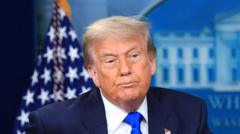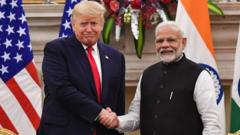The trade pact emphasizes collaboration between the United States and Vietnam while addressing concerns about tariff avoidance through transshipping goods from China.
Trump Secures Initial Trade Agreement with Vietnam to Mitigate Tariffs

Trump Secures Initial Trade Agreement with Vietnam to Mitigate Tariffs
In a significant economic move, President Trump announced a preliminary trade agreement with Vietnam aimed at rolling back tariffs on U.S. imports from the country.
On July 2, 2025, President Trump revealed the preliminary trade agreement with Vietnam, indicating plans to reduce some tariffs imposed on Vietnamese goods. In exchange, the country will facilitate greater access to American products within its market. According to Trump, this deal is intended to bolster cooperation between the two nations, as articulated in a post shared on Truth Social, stating, “It will be a Great Deal of Cooperation between our two Countries.”
Importantly, the agreement establishes a 20 percent tariff on all imports from Vietnam, alongside a steep 40 percent levy on products viewed as tranships. This measure specifically targets concerns that Vietnam has become a conduit for Chinese goods to circumvent U.S. tariffs. The precise nature of the products impacted by the revised tariffs has yet to be clarified, as it remains unclear whether the products refer to those made in Vietnam with Chinese components or those originating directly from China.
Commerce Secretary Howard Lutnick emphasized that merchandise from other countries routed through Vietnam into the U.S. would incur the 40 percent tariff, thereby reinforcing the administration's efforts to regulate trade loopholes.
As U.S. imports from Vietnam have surged since tariffs were levied on China during Trump's initial term, this new agreement is set to reshape trade dynamics in the region significantly. With a gradual shift on the horizon, importers and manufacturers will need to navigate this new tariff landscape carefully.
This early-stage agreement marks a pivotal moment in U.S.-Vietnam relations, aligning both nations towards a future of increased economic interdependence, while also addressing the larger complexities that arise from global manufacturing practices.
Importantly, the agreement establishes a 20 percent tariff on all imports from Vietnam, alongside a steep 40 percent levy on products viewed as tranships. This measure specifically targets concerns that Vietnam has become a conduit for Chinese goods to circumvent U.S. tariffs. The precise nature of the products impacted by the revised tariffs has yet to be clarified, as it remains unclear whether the products refer to those made in Vietnam with Chinese components or those originating directly from China.
Commerce Secretary Howard Lutnick emphasized that merchandise from other countries routed through Vietnam into the U.S. would incur the 40 percent tariff, thereby reinforcing the administration's efforts to regulate trade loopholes.
As U.S. imports from Vietnam have surged since tariffs were levied on China during Trump's initial term, this new agreement is set to reshape trade dynamics in the region significantly. With a gradual shift on the horizon, importers and manufacturers will need to navigate this new tariff landscape carefully.
This early-stage agreement marks a pivotal moment in U.S.-Vietnam relations, aligning both nations towards a future of increased economic interdependence, while also addressing the larger complexities that arise from global manufacturing practices.




















